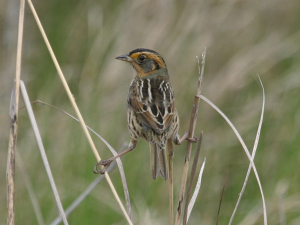Saltmarsh Conservation in the ACJV
In July, 2015, the Atlantic Coast Joint Venture (ACJV) hosted a workshop to facilitate communication about current saltmarsh conservation efforts, focusing both on science (research, monitoring, conservation design, and decision-support tools) and implementation efforts. Below, you can download keynote presentations, which provide cutting-edge examples of saltmarsh conservation, and learn more about existing science and implementation projects underway in our region.
Background
Saltmarsh habitat is one of the most important–and one of the most threatened–habitats for migratory birds in the Atlantic Flyway. The only native migratory bird species endemic to the ACJV, the Saltmarsh Sparrow (Ammodramus caudacutus), is found only in saltmarsh habitat—and breeds within a relatively narrow band of “high marsh” vegetation. Seaside Sparrow (Ammodramus maritimus) is also restricted to saltmarsh habitat; most of its recognized subspecies are of conservation concern:
The Black Rail (Laterallus jamaicensis) is another saltmarsh species of high conservation concern that has been petitioned for federal protection status; nearly absent form the Atlantic Flyway. Saltmarsh provides vital wintering habitat to one of the most iconic species in the flyway, the American Black Duck (Anas rubripes).
Despite being considered one of the most productive ecosystems on earth, the vast majority of saltmarsh habitat in portions of the Atlantic Flyway have been destroyed due to human development (i.e., buildings and roads) or highly modified and degraded by ditching or dredging. Sea-level rise from global warming now poses a major threat to the habitat remaining. Consequences of saltmarsh loss affect much more than just migratory birds. Tidal marshes provide critical nursery habitat for juvenile fish and shellfish, supporting the multi-billion dollar Atlantic Coast fisheries industry. Coastal marshes also provide important protection to human communities, providing regular flood control and reducing damage from catastrophic coastal storms.
Key Note Presentations
These keynote presentations provide examples that can help guide the conservation efforts of partners throughout the flyway, providing them with important tools or examples of saltmarsh conservation on the ground.
Saltmarsh Habitat Avian Research Program (SHARP)
Black Duck Non-breeding Habitat Conservation
Marshes for Tomorrow: Atlantic Flyway Saltmarsh Initiative
Saltmarsh Conservation Science in the North Atlantic LCC
Saltmarsh Conservation Science in the South Atlantic LCC
Research, Monitoring & Planning Tools
Here is a summary of many science (including conservation design and decision support tools) projects underway or recently completed in the Atlantic Flyway.
Implementation Efforts
This table lists current, or recently completed efforts to protect, restore, enhance, or manage saltmarsh habitat.

